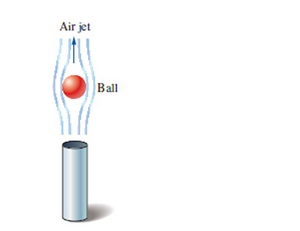
One of the popular demonstrations in science museums involves the suspension of a ping-pong ball by an upward air jet. Children are amused by the ball always coming back to the center when it is pushed by a finger to the side of the jet. Explain this phenomenon using the Bernoulli equation. Also determine the velocity of air if the ball has a mass of 3.1 g and a diameter of 4.2 cm. Assume the air is at 1 atm and 25°C. 
FIGURE P11-68
The velocity of air and an explanation of the phenomenon using Bernoulli equation.
Answer to Problem 68P
The velocity of the air is
Explanation of Solution
Given information:
The mass of the ball is
Write the expression for the drag force acting on the ball.
Here, the drag ball on the ball is
Write the expression for the buoyancy force acting on the ball.
Here, the buoyancy force is
Write the expression for the weight of the body.
Here, the weight of the body is
Write the expression for the Reynolds number.
Here, the Reynolds number is
Write the expression for the weight of the ball.
Here, the mass of the ball is
Write the expression for the Bernoulli's equation.
Here, the pressure at the point 1 is
Calculation:
Substitute
Substitute
Substitute
Substitute
Refer the Table-11.2, "Representative drag coefficients for various three dimensional bodies based on the frontal area for Reynolds number unless stated otherwise" to obtain the value of the coefficient of drag is
Substitute
Refer the Table-B-1, "Physical properties of air at standard atmospheric Pressure" to obtain the value of the kinematic viscosity is
Substitute
By using the Bernoulli's equation, the datum at the point 1 is lesser then the datum at the point 2. If the ball is pushed by the finger to the side of the jet, the ball will come back to the centre of the jet. This is so because, in the middle portion of the jet, the velocity is higher than the velocity at point 1, which is,
Conclusion:
The velocity of the air is
Want to see more full solutions like this?
Chapter 11 Solutions
Fluid Mechanics: Fundamentals and Applications
- What is the characteristic aspect of Rayleigh flow? What are the main assumptions associated with Rayleigh flow?arrow_forwardWhat is the effect of heat gain and heat loss on the entropy of the fluid during Rayleigh flow?arrow_forwardThe weight of a thin flat plate 50 cm × 50 cm in size is balanced by a counterweight that has a mass of 2 kg, as shown. Now a fan is turned on, and air at 1 atm and 25°C flows downward over both surfaces of the plate (front and back in the sketch) with a free-stream velocity of 10 m/s. Determine the mass of the counterweight that needs to be added in order to balance the plate in this case.arrow_forward
- A U-tube open at both ends is partially filled with water. Oil having a density of 750 kg/m3 is then poured into the right arm and forms a column L = 10.00 cm high. The density of air is 1.29 kg/m3.The right arm is then shielded from any air motion while air is blown across the top of the left arm until the surfaces of the two liquids are at the same height. (d) Determine the pressure difference between the water and oil columns(e) Determine the speed of the air being blown across the left arm.arrow_forwardIs the sonic velocity in a specified medium a fixed quantity, or does it change as the properties of the medium change? Explainarrow_forwardThe velocity and temperature of the flow ahead of a normal shock wave are 1215 m/s and 300 K, respectively. Calculate the velocity of the flow behind the shock.arrow_forward
- When an airplane is flying at a constant speed relative to the ground, is it correct to say that the Mach number of this airplane is also constant?arrow_forwardUse the thermal wind equation to explain the presence of the jet stream.arrow_forwardIn which medium does a sound wave travel faster: in air at 20°C and 1 atm or in air at 20°C and 5 atm?arrow_forward
- How do oblique shocks occur? How do oblique shocks differ from normal shocks?arrow_forwardA 20 cm diameter pipe carries air at 24 m / s at a pressure of 148 kpa absolute pressure and 27 ° C. What is the mass flow rate of air? the 20 cm pipe is reduced to 10 cm and the temperature and pressure are 11 ° C and 130.5 kpa. Determine the velocity in the 10cm pipe and the volume flow in both pipesarrow_forwardA high-speed aircraft is cruising in still air. How does the temperature of air at the nose of the aircraft differ from the temperature of air at some distance from the aircraft?arrow_forward
 Elements Of ElectromagneticsMechanical EngineeringISBN:9780190698614Author:Sadiku, Matthew N. O.Publisher:Oxford University Press
Elements Of ElectromagneticsMechanical EngineeringISBN:9780190698614Author:Sadiku, Matthew N. O.Publisher:Oxford University Press Mechanics of Materials (10th Edition)Mechanical EngineeringISBN:9780134319650Author:Russell C. HibbelerPublisher:PEARSON
Mechanics of Materials (10th Edition)Mechanical EngineeringISBN:9780134319650Author:Russell C. HibbelerPublisher:PEARSON Thermodynamics: An Engineering ApproachMechanical EngineeringISBN:9781259822674Author:Yunus A. Cengel Dr., Michael A. BolesPublisher:McGraw-Hill Education
Thermodynamics: An Engineering ApproachMechanical EngineeringISBN:9781259822674Author:Yunus A. Cengel Dr., Michael A. BolesPublisher:McGraw-Hill Education Control Systems EngineeringMechanical EngineeringISBN:9781118170519Author:Norman S. NisePublisher:WILEY
Control Systems EngineeringMechanical EngineeringISBN:9781118170519Author:Norman S. NisePublisher:WILEY Mechanics of Materials (MindTap Course List)Mechanical EngineeringISBN:9781337093347Author:Barry J. Goodno, James M. GerePublisher:Cengage Learning
Mechanics of Materials (MindTap Course List)Mechanical EngineeringISBN:9781337093347Author:Barry J. Goodno, James M. GerePublisher:Cengage Learning Engineering Mechanics: StaticsMechanical EngineeringISBN:9781118807330Author:James L. Meriam, L. G. Kraige, J. N. BoltonPublisher:WILEY
Engineering Mechanics: StaticsMechanical EngineeringISBN:9781118807330Author:James L. Meriam, L. G. Kraige, J. N. BoltonPublisher:WILEY





